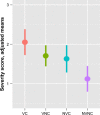Colds as predictors of the onset and severity of COPD exacerbations
- PMID: 28331305
- PMCID: PMC5354536
- DOI: 10.2147/COPD.S127146
Colds as predictors of the onset and severity of COPD exacerbations
Abstract
Rationale: Common colds are associated with acute respiratory symptom exacerbations in COPD patients.
Objective: To determine exacerbation risk and severity in COPD patients with/without coincident self-reported colds.
Methods: Global initiative for chronic Obstructive Lung Disease stage I-IV COPD patients electronically transmitted respiratory symptom diaries to research staff daily between December 2006 and April 2009. Respiratory symptom worsening prompted contact by a study nurse and patient assessment to determine if a cold was present or an exacerbation underway. A composite daily symptom score was derived for each subject from diarized symptom data. The exacerbation/cold/virus relation was examined using a Poisson regression model, the relation of colds to respiratory symptom severity using generalized estimating equation models.
Results: Daily diary transmission compliance of >97% enabled detection of all possible exacerbations. Among 262 exacerbations meeting Anthonisen criteria, 218 (83%) had cold-like symptoms present at their inception, but respiratory viruses were detected in only 106 (40%). Within-subject exacerbation risk was 30 times (95% confidence interval [CI]: 20, 47; P<0.001) greater with colds present. Compared to cold- and virus-negative exacerbations (n=57), the mean increase in composite symptom score in those cold and virus positive (n=79) was 0.93 (95% CI: 0.61, 1.25; P<0.001), cold-positive and virus-negative exacerbations (n=100) 0.51 (95% CI: 0.21, 0.81; P<0.001), cold-negative and virus-positive exacerbations (n=26) 0.58 (95% CI: 0.23, 0.94; P<0.001).
Conclusion: This study emphasizes the importance of colds in COPD exacerbation risk and severity, even in the absence of virus detection. COPD patients should act promptly when cold symptoms appear to facilitate early intervention for exacerbation prevention or management.
Keywords: COPD epidemiology; COPD exacerbations; common cold; respiratory infection; respiratory viruses.
Conflict of interest statement
Disclosure Mr Johnston has received research funding and/or honoraria from Merck Canada, Inc., GlaxoSmithKline Canada, and AstraZeneca PLC. Dr McIvor has received honoraria from pharmaceutical companies, including AstraZeneca, Boehringer Ingelheim, Takeda, Pfizer, Merck, and GlaxoSmithKline for educational events, advisory boards, and Phase 3 clinical trials. Authors Gerhardsson de Verdier, Gustafson, McCrae, Edsbäcker, and Olsson are employed by AstraZeneca and own shares in the company. Professor Coyle has received honoraria from pharmaceutical companies (Roche, Randox, and Abbott) for educational events, advisory boards, and is a founding director of the start-up company Hibergene. The authors report no other conflicts of interest in this work.
Figures


Comment in
-
Blocking rhinoviral adhesion molecule (ICAM-1): potential to prevent COPD exacerbations.Int J Chron Obstruct Pulmon Dis. 2017 May 11;12:1413-1414. doi: 10.2147/COPD.S138612. eCollection 2017. Int J Chron Obstruct Pulmon Dis. 2017. PMID: 28546749 Free PMC article. No abstract available.
References
-
- Hurst JR, Vestbo J, Anzueto A, et al. Susceptibility to exacerbation in chronic obstructive pulmonary disease. N Engl J Med. 2010;363(12):1128–1138. - PubMed
-
- Johnston SL. Overview of virus-induced airway disease. Proc Am Thorac Soc. 2005;2(2):150–156. - PubMed
-
- Upshur RE, Knight K, Goel V. Time-series analysis of the relation between influenza virus and hospital admissions of the elderly in Ontario, Canada, for pneumonia, chronic lung disease, and congestive heart failure. Am J Epidemiol. 1999;149(1):85–92. - PubMed
Publication types
MeSH terms
LinkOut - more resources
Full Text Sources
Other Literature Sources
Medical
Miscellaneous

